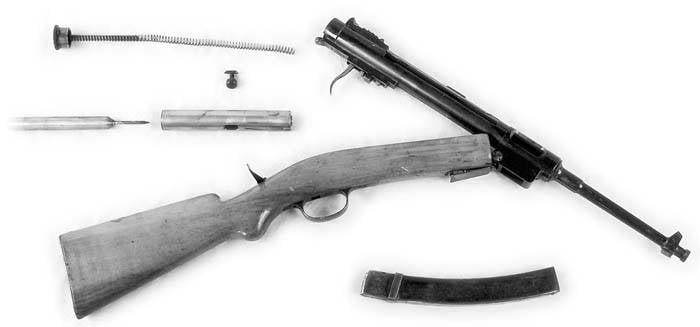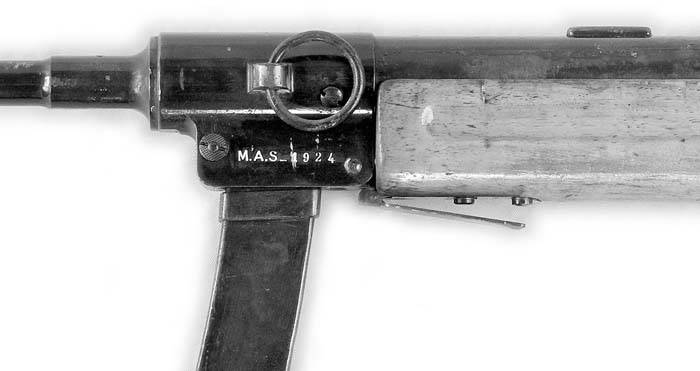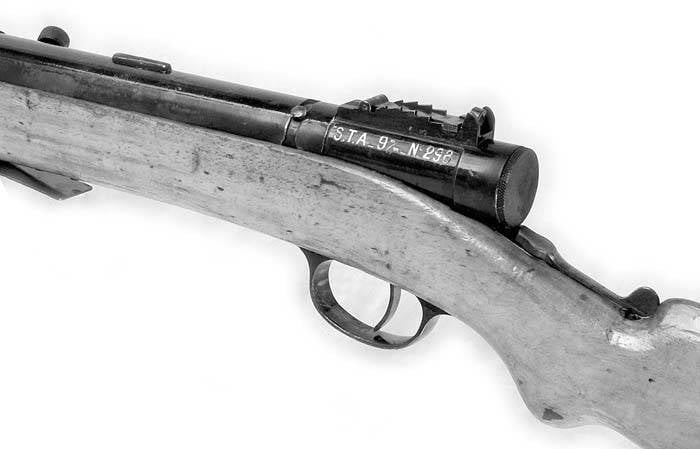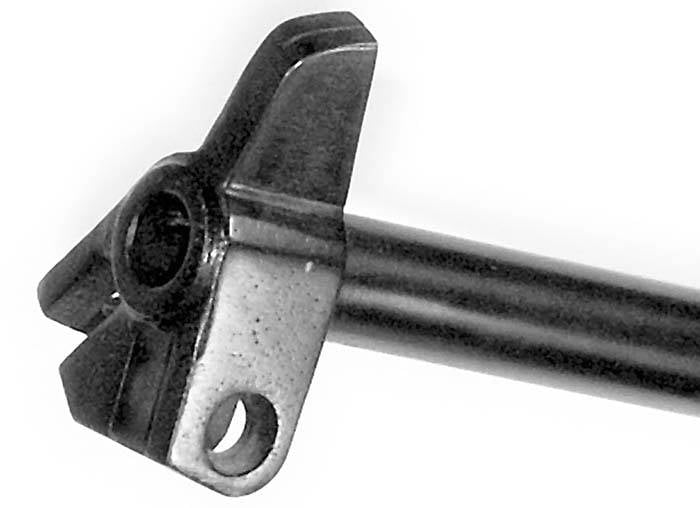Submachine guns STA 1922 / 1924 (France)
Since 1919, the French command has been analyzing the experience of recent battles, as well as studying captured weapons. Studies have shown all the advantages of existing submachine guns and weapons of some other classes. 11 May 1921, the military department issued an order to develop a number of new types of weapons, including several machine guns, automatic pistols and submachine guns. Shortly before the appearance of the order, technical tasks for advanced weapons were formed.

Submachine gun STA 1924, equipped with a bipod
The military, after examining the existing models, demanded the development of an automatic weapon for a pistol cartridge capable of displaying a high density of fire at ranges up to 200 m. It was necessary to ensure the rate of fire at the level of 400-500 shots per minute. The weapon was supposed to use detachable magazines on 25 ammunition type 9x19 mm "Parabellum". The technical assignment also stipulated the required parameters of accuracy and accuracy, the design of the sight, etc. In terms of ergonomics, the submachine gun was supposed to resemble existing rifles. At the same time, the bipod of the most advantageous design should be used.
Several major organizations of the French arms industry were involved in the work on the draft submachine gun. The engineers of the Section Technique de l'Artillerie (STA), the experimental group Camp de Satory and the plant Manufacture d'armes de Saint-Étienne (MAS) were to present their variants of the appearance of the new weapon. Having compared several promising projects, the military planned to choose the most successful one. It is curious that the subsequent choice of the army was not brought out by the "losers" organizations from the project. Thus, the STA weapons were planned to be manufactured at the MAS plant.
It should be noted that the French gunsmiths became interested in the subject of submachine guns much earlier than the military wished to receive such weapons. STA specialists began to study this area as early as 1919, and by the beginning of the new program they had time to complete some of the preliminary work. Due to this, the creation of a new project that met the requirements of the customer did not take long. A prototype for factory testing was assembled in October 1921 of the year. In the next 1922, several similar items were handed over to the military for inspections in the army.
The first version of the submachine gun was designated STA Modèle 1922. Modified versions of the project had their own designations, such as STA 1924, STA 1924 M1, etc. Also in the name of the weapon is often indicated the manufacturer. In this case, the name looked like STA / MAS 1924. The fact that the project at different times offered prototypes of different appearance and with different names, can lead to certain difficulties.
The gunsmiths of the Section Technique de l'Artillerie, starting work in 1919, took the German MP 18 submachine gun as a basis for their advanced weapons. Thus, the future STA 1922 was based on borrowed ideas, and also partially repeated the existing design. Nevertheless, almost all new parts were developed from scratch, which does not allow us to consider the French product as just a copy of the German one. Numerous innovations of one kind or another, related to ergonomics and operating features, further remove the French project from the “basic” German one.

Weapon without bipod
The new submachine gun was supposed to be built according to the scheme traditional for that time. It was proposed to use a simplified receiver mounted on a wooden bed. The weapon should have been equipped with a barrel that was not equipped with its own protective casing. In this case, the bipod was placed on the trunk. It was proposed to use detachable stores, the design of which partially repeated one of the foreign products. In the course of further development of the project, such architecture was preserved, however, individual structural elements were regularly updated.
The submachine gun STA 1922 was equipped with a rifled 9-mm barrel with a length of 215 mm (24 caliber). The barrel had a cylindrical outer surface with a pair of bulges in the muzzle and breech. Front thickening was intended for flies and bipods. The rear contained a chamber, and also provided the connection of the barrel with the receiver. Unlike many other samples of its class, the French submachine gun was not supposed to be equipped with a barrel cover. Any means facilitating the transfer of heat to atmospheric air were also not envisaged.
The project proposed the use of a simple receiver in the form of a tube of sufficient length, closed with a stopper behind it. In the early versions of the project, the receiver was supposed to be made of duralumin, which made it possible to obtain the required strength with a noticeable reduction in mass. The receiver had several windows and slots. In front of it there was a receiving window of the store and a window for ejection of the sleeves. A long groove for the bolt handle passed along the right wall. The receiver box was connected to the box with a hinge in the front and a lever at the back. For incomplete disassembly, the box was folded forward.
From a certain time, the receiver was supplemented with a movable lid that covered the groove of the bolt handle. By moving the bolt forward and moving its handle, the shooter could turn the cover clockwise relative to the weapon axis. In this position, the cover protected the longitudinal slot in the wall of the receiver, preventing the ingress of dirt into the weapon.
The weapon received the simplest automatic on the basis of a free gate. The shutter itself was a massive steel part, the shape of which was close to cylindrical. Inside the gate a channel was provided for a moving drummer. Near the mirror there was a groove for installing a spring-loaded extractor. On the right side of the gate was a slot for mounting the cocking handle.

Incomplete disassembly of the serial STA 1924
Inside the gate was placed a movable drummer, made in the form of a cylindrical device with a needle striker in the front. The back end of the hammer rested against the reciprocating spring. The latter was located in the rear of the receiver. In order to avoid displacement relative to the required position, the spring was put on the longitudinal guide rod. He performed at the same time with the back cover of the receiver.
The trigger mechanism was extremely simple, and did not take up much space. The trigger with the sear and its own spring was mounted on a small frame located under the back of the receiver. Before the shot, the bolt was in the extreme rear position and was fixed with a sear. After pressing the trigger, the bolt and hammer had to move forward, send the cartridge and execute a shot.
From a random shot, the STA 1922 product was protected in the simplest way. The slot for the bolt handle had a small slot in the upper part. By moving the bolt back, the shooter could put his grip in this slot, which excluded the shot. As part of the USM own means of blocking is not provided.
The detachable magazine for STA 1922 was developed on the basis of a similar product for the Italian submachine gun Villar-Perosa Modello 1918. He was distinguished by a curved shape and contained X-NUMX cartridges "Parabellum". To reduce the weight of the weapon and its ammunition, the shop had to be made of duralumin. The store was placed in a small receiving shaft under the front of the receiver.
The first French submachine gun was completed with an open sight, which allowed firing at ranges from 100 to 600 m. The sight was adjusted by moving the rear sight along with its movable base. In the muzzle of the trunk was located the front sight, which did not have the possibility of adjustment to the side wind.

Front of receiver and receiver
It was proposed to equip the weapon with a wooden box, partially repeating parts for rifles. The front cut of the box was immediately behind the receiver of the store and was equipped with metal parts for the hinge. The stock was completed with a metal trigger guard. The neck of the butt got a pistol projection. Rear section of the butt had a metal butt plate. On the butt and on the left wall of the receiver, at the level of the receiver of the store, were placed anabs for a belt.
In accordance with the requirements of the customer, the designers of Section Technique de l'Artillerie equipped their submachine gun with a bipod. A device with a pair of sliding supports was fixed on the muzzle of the barrel. To transport the legs of the bipod came together, fastened with a lock and fit under the trunk. It was assumed that the presence of a bipod will improve the accuracy and accuracy of fire when firing with an emphasis. At the same time, the folded bipod should not interfere in other situations. It is known about the existence of several prototypes with a one-legged bipod.
The length of the STA 1922 submachine gun was 830 mm with a mass less than 2,7 kg (without a magazine). The technical rate of fire reached 600-650 shots per minute. The sight allowed to shoot at a distance of 600 m, but the effective range of fire was three times less.
At the beginning of 1922, several experienced submachine guns developed by the STA organization were presented to military experts. According to the results of the first tests, the developers received several recommendations for weapons refinement. Duralumin parts did not justify themselves, being overly expensive and difficult to manufacture. The sight for shooting at 600 m did not make sense. Shop on 40 cartridges also found redundant. The rest of the weapons presented, in general, satisfied the customer.
Improvements to the original project took some time, and new prototypes were put to the test only for the 1924 year. The new submachine gun, designated STA 1924, had a steel receiver and a new sight. Steel shops were also made on the 32 cartridge. To control the ammunition consumption, longitudinal windows were provided in the rear wall of the store. According to its characteristics, the new STA 1924 was almost the same as the base STA 1922.

Receiver, scope and neck of the stock
Working on the development of an existing project, the designers from STA proposed several new ideas. The weapon could be equipped with a protective cover for the receiver of the shop, a trigger mechanism with a choice of fire mode, a bayonet, and updated fittings. Upon receipt of customer approval, these innovations could be introduced into the design of weapons. However, the military was not interested in such a proposal, and serial STA 1924 had to repeat the design of experimental products.
In the 1924 year, according to the results of comparative tests of several submitted samples, the draft Section Technique de l'Artillerie was recognized as the most successful. The consequence of this was the order for the production of a relatively large batch of weapons intended for military trials. Factory Manufacture d'armes from Saint-Étienne ordered the release of 300 submachine guns. Half planned to transfer for trial operation in the infantry. 80 units were for artillery, 40 for cavalry and 10 for armored forces. 10 products still had to go through rigorous testing at the test site, while the remaining ten STA 1924 were redundant.
Submachine guns, now also referred to as STA / MAS 1924, passed all the necessary checks, the results of which the engineers again received recommendations in the context of the finalization of the project. The product needed to improve some details and improve ergonomics. After such modifications, weapons could be put into service and enter the series.
In 1925, the STA Modèle 1924 modifié 1 or STA 1924 M1 submachine gun was launched for testing. He fully met all the requirements, and was recommended for adoption. This decision was confirmed by an order from August 11. Soon the MAS plant received an order for the release of a new model 8250 submachine guns. The first batch of serials was supposed to go to the troops as soon as possible. In the meantime, the manufacturer was engaged in setting up production and preparing production facilities.
Designers from STA and employees of the MAS plant continued technological improvement of weapons, which, however, led to delays in work. By March, 1926 was able to assemble only 10 serial products, after which production was stopped. As it became clear later, the weapon assembly was stopped forever. In early July, the command launched a new small arms development program, in which there was no room for the existing STA 1924. According to other data, before the appearance of a new order, the plant from Saint-Étienne managed to collect several hundred submachine guns and bring the total number of the entire family to more than 1000.

On the muzzle of the trunk was placed a block with a front sight and a leg of a bipod.
For several reasons, the military changed one of the basic requirements for a promising submachine gun. Now, weapons of this class should have used 7,65 caliber cartridges of one of the two proposed types. The 9-mm submachine gun from the Section Technique de l'Artillerie and the Manufacture d'armes de Saint-Étienne did not meet these requirements. Fast processing of the project under the new cartridge was excluded. As a result, the batch of STA / MAS 1924 M1 products, released by spring 1926, was the last.
In just a few years, at least 1922 submachine guns were assembled for STA / MAS 1924 / 320 projects. STA 1922 and STA 1924 M1 products were the smallest - about a dozen of each type. The largest number of such weapons was collected by the STA / MAS 1924 project, and it was intended for military trials. Serial products like “M1”, which most fully met the customer's requirements, could not become mass.
According to known data, more than three hundred submachine guns of several models remained in operation for a certain time, but could not claim to lead in their niche. The emergence of new weapons in the future led them out of the game. However, a number of STA 1924 submachine guns could get to the front. In 1926-27, these weapons were used by French soldiers during the Reef War in Northern Morocco.
According to some reports, some STA / MAS 1924 products remained at least until the beginning of the forties. There are references to the use of this weapon by the French Resistance. However, such exploitation was not massive, although it made a definite contribution to the fight against occupation.
As far as we know, all the machine guns produced by the first French projects were eventually destroyed. Some of these products were disposed of as unnecessary, while others were lost during the battles. Anyway, until our time, no such product has survived. It can be assumed that, with a different course of events, now the STA / MAS 1922 / 1924 submachine guns would be of particular interest to museums and collectors.
According to the results of the first program for the development of pistol-machine guns, the French military department decided to abandon existing projects and in the future build similar weapons for cartridges with an 7,62-mm bullet. Soon, the development of new projects began, but their real results appeared very late - only in the second half of the thirties.
Based on:
http://smallarmsreview.com/
http://modernfirearms.net/
http://forgottenweapons.com/
Popenker MR, Milchev M.N. World War II: gunsmiths war. - M .: Yauza, Eksmo, 2008
Information